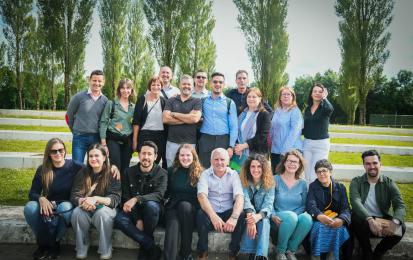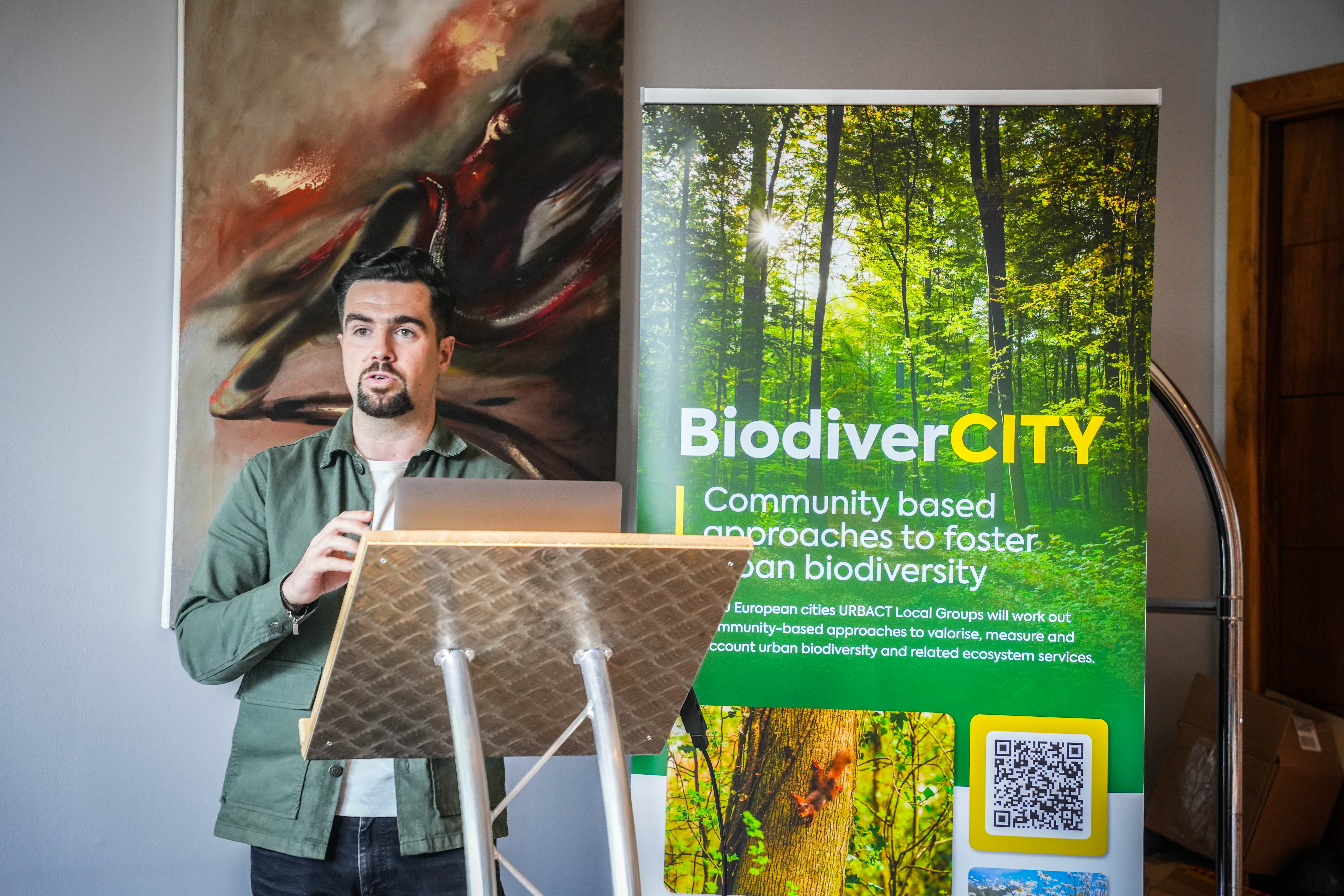What does a powerful GBI strategy look like?
Limerick’s GBI strategy aims to guide the urban planning and management process of multi-functional green and blue spaces, helping drive the transition to a low-carbon society and forming a cornerstone of sustainable development. It is not a ‘must have’ paper - it tackles local and global scale challenges, offering multiple economic, social and environmental benefits.
It is not limited to traditional green spaces such as parks, but it targets all types of green and blue areas. The GBI Strategy explains the benefits that natural assets can deliver to residents, visitors and the entire ecosystem (linked to both physical and mental well-being). It aims to make a corridor connecting green and blue areas (this Blue Green Ring’ around Limerick is Ireland’s first city-scale planning and ecosystems enhancement programme) and besides the creation of high-quality, attractive, and functional places, it targets the negative impact of habitat loss and climate change at the same time.
The evidence base for the multi-functional benefits of GBI is constantly evolving, thus besides the benefits for biodiversity, climate change and health, the GBI Strategy targets benefits for the economy as well.
In line with this, Limerick’s GBI strategy focuses on four key challenges and identifies four spaces (overlapping each other):
Health Challenge - Improving health and well-being outcomes – creation of ‘Healthy Spaces’
Climate Challenge - Climate adaptation – creation of ‘Resilient Spaces’
Biodiversity Challenge - Ecological improvements –creation of ‘Wilder Spaces’
Economic Challenge - Recreation, income generation and regeneration – the creation of ‘Destination Spaces’.

The Biodcivercity team. Photo by Limerick City and County Council
By aiming to increase the use of nature-based solutions throughout Limerick, including urban greening interventions such as green roofs/walls and sustainable drainage systems, the GBI Strategy is incorporated into the Local Authority Climate Action Plan and in line with the Development Plan 2022-2028.
Its 10 priority actions highlight well the core themes behind green and blue infrastructure as well as nature-based solutions in the urban context.
Embed GBI in the implementation of public and private projects.
Enhance existing open space provision within the area.
Create new formal parks and natural & seminatural parks to improve accessibility for a growing population.
Protect, value and enhance amenity green space by applying an appropriate management approach.
Enhance, protect and develop the network of blue-ways.
Integrate GBI in the delivery of the network of active travel routes.
Enhance recreational access to the local river and tributaries.
Develop Tree and Biodiversity Strategies for the area.
Promote community engagement and raise public awareness in the development of GBI.
Incorporate smart mechanisms of connecting GBI initiatives with the public.
Action planning based on a GBI strategy
As Limerick City and County Council is responsible for the planting, maintenance and management of trees in public spaces (e.g. streets, greenways, parks, public buildings, and residential greenspaces), LCCC has created a framework to inform and support decisions made by the LCCC on the management and development of a sustainable tree population in the city and county.
This is one example of how the GBI Strategy derived further action plans, targeting specific elements of the green infrastructure. Another example is the Local Authority Biodiversity Action Plan. Based on a national regulation, LCCC has appointed its Local Authority Biodiversity Officer. One of the main tasks of the Biodiversity Officers is to develop and implement an effective Local Authority Biodiversity Action Plan, “aiming to serve as a comprehensive manual, offering insights into best practice, policy frameworks, and strategic and action-based planning for biodiversity conservation at the local level”.
The Biodiversity Action Plan “outlines the objectives and actions needed to protect and enhance biodiversity within a specific local authority area. The plan should be developed in the context of both national and international biodiversity commitments as well as regional and local policies, priorities and local consultation. A local biodiversity action plan provides the context for the local authority to work with and support local communities, agencies, NGOs and landowners, to develop plans, policies and projects to record, restore and conserve their local biodiversity within a regional and national context”.

Photo by Limerick City and County Council
Why does urban biodiversity matter?
Urban biodiversity as a category refers to the variety of living organisms as well as the multiplicity of habitats in and around dense human settlements. The conservation work to mitigate biodiversity loss is more or less the same in the city and outside of urban areas, however, some sub-themes such as awareness-raising, mitigating the heat-island effects and other urban disaster risks, green infrastructure and the fight against invasive species make the urban aspects important within biodiversity conservation. The most important thing is that cities offer unique opportunities for learning and education about a resilient and sustainable future and have a large potential to boost innovations and governance tools. In addition, the following aspects should be taken into consideration regarding urban biodiversity:
Both the size and quality of green spaces matter. Biodiversity declines rapidly when green space is too small. The size widely depends on the climate and the species which are often area-sensitive and intolerant of urban environments, but larger areas generally support greater biodiversity because they contain more kinds of habitats and provide more resources than smaller patches. In some cases, urban areas hide very rich habitats, even if they are fragmented. Cities can also support biodiversity by increasing the quality of existing urban green spaces and by creating networks of habitat patches.
Connectivity is key since green corridors can effectively facilitate the movement of plants and animals between green patches. These can be flowerbeds supporting pollinators, alleys of bushes or trees along the streets, waterways and greenways, hedges, pocket parks, green roofs and walls, rain gardens, and - of course - privately owned gardens - linking wider greenspaces.
Habitat restoration is key since different, healthy habitats can support greater overall biodiversity. Urban planning and design shall map habitat zones across the city, based on both what habitat types were present historically and what plant communities are appropriate today and under future conditions. The heterogeneity of habitat zones across the landscape is crucial to support a diversity of native wildlife. Protecting rare native habitats in cities can be particularly beneficial for habitat specialists, which may be especially vulnerable to habitat loss. Habitat diversity is important from the site scale to the city scale, including creating a rich diversity of vertical structure of the vegetation. Biodiversity-driven park maintenance can efficiently support habitat diversity. For example, large trees and well-designed urban water bodies serve as hubs for local biodiversity. Trees with cavities for nesting birds and woody debris piles for reptiles and insects, which are typically removed in urban environments, can support specialists and increase biodiversity in otherwise resource-limited areas. Artificial structures such as nest boxes and bat caves can provide critical features in small spaces.
Native vegetation is often better. Selecting native species that are likely to be tolerant of future climate conditions can create a climate-adaptive native or largely native plant palette. In addition, native plants support the native wildlife with which they have co-evolved (e.g. native species often develop particular relationships with one another, with other species and with their physical environment). Native plants thus can bolster the entire food web by supporting the presence of these specialized local insects, which can, in turn, be a food resource for other wildlife.
Community engagement is also key to making changes in the entire urban landscape. Local authorities are the best-positioned bodies of the government to facilitate actions that are both beneficial to biodiversity and lower in cost. Biodiversity-friendly management actions include reducing pesticide and herbicide use, minimizing disturbance to sensitive wildlife areas, biodiversity-driven maintenance techniques, limiting the impacts of domestic cats and dogs, reducing light and noise pollution, and regulating human activity to reduce conflict with wildlife.


